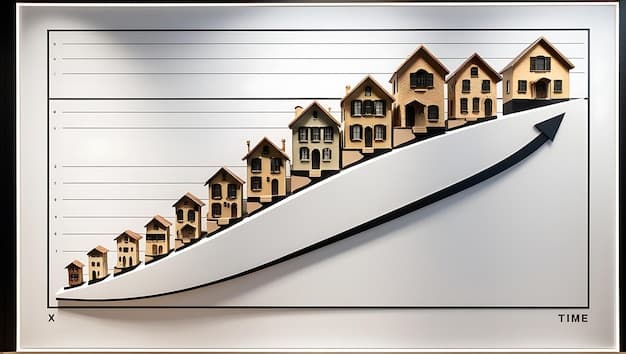Is Now the Time to Refinance? Analyzing Mortgage Rate Trends

Is now the time to refinance? Analyzing mortgage rate trends for the next 6 months involves considering current economic conditions, Federal Reserve policies, and individual financial goals to determine if refinancing aligns with potential savings and long-term financial stability.
Navigating the realm of mortgage refinancing requires careful consideration of market dynamics. This article dives into whether is now the time to refinance? Analyzing mortgage rate trends for the next 6 months to help you make an informed decision.
Understanding Current Mortgage Rate Trends
Analyzing current mortgage rate trends is crucial for homeowners contemplating refinancing. Understanding the factors that influence these rates can provide valuable insights.
Let’s delve into what’s shaping the market right now.
Key Economic Indicators
Economic indicators play a significant role in mortgage rate fluctuations. Monitoring these indicators can help predict future rate movements.
- Inflation Rates: Higher inflation often leads to higher mortgage rates as the Federal Reserve attempts to curb inflation by raising interest rates.
- GDP Growth: Strong GDP growth can also push rates higher due to increased demand for credit and investment.
- Employment Numbers: Positive employment data usually indicates an economy, potentially leading to higher rates.
Federal Reserve Policies
The Federal Reserve’s monetary policies directly impact mortgage rates. Changes in the federal funds rate serve as a benchmark for other interest rates.
Understanding these policies is vital for predicting rate trends.

In conclusion, current mortgage rate trends are influenced by various economic factors and Federal Reserve policies, so it’s essential to stay informed and consult with financial professionals to make informed decisions.
Factors Influencing Mortgage Rates in the US
Several factors uniquely influence mortgage rates, understanding these can provide insight into the potential direction of mortgage rates over the next six months.
Let’s break down the main drivers.
The 10-Year Treasury Yield
The 10-year Treasury yield is a benchmark for mortgage rates. It reflects investor confidence in the U.S. economy.
A rising yield often signals higher mortgage rates.
- Safe Haven Status: During economic uncertainty, investors flock to U.S. Treasuries, driving down yields and potentially lowering mortgage rates.
- Inflation Expectations: If investors anticipate higher inflation, they will demand higher yields to protect their investments, pushing mortgage rates up.
- Global Economic Conditions: Global events and economic conditions can also impact the demand for U.S. Treasuries, influencing yields.
Mortgage-Backed Securities (MBS)
Mortgage-backed securities are another critical factor. The demand for MBS directly affects mortgage rates by influencing the available supply of mortgage funds.
This demand fluctuates based on market conditions.

In conclusion, factors influencing mortgage rates—including the 10-year Treasury yield and MBS demand—play a significant role. Staying informed about these elements can help in making better, more informed financial decisions.
Analyzing Expert Predictions for the Next 6 Months
Expert predictions offer a glimpse into future mortgage rate trends. Analyzing these predictions can help in strategic financial planning.
Let’s review what the experts are saying.
Summarizing Forecasts from Leading Financial Institutions
Financial institutions regularly publish mortgage rate forecasts. These forecasts are based on extensive economic analysis and can offer valuable insights.
Staying updated with those can provide confidence.
Potential Scenarios and Their Impact on Refinancing
Several potential economic scenarios could impact refinancing opportunities. Understanding these scenarios can help homeowners prepare for different outcomes.
- Scenario 1: Stable Economic Growth: If the economy continues to grow at a steady pace, mortgage rates may remain relatively stable.
- Scenario 2: Economic Slowdown: An economic slowdown could lead to lower mortgage rates as the Federal Reserve attempts to stimulate the economy.
- Scenario 3: Inflation Surge: A resurgence in inflation could push mortgage rates higher as the Federal Reserve tightens monetary policy.
Ultimately, it’s essential to stay informed and consult with financial professionals to make the most informed decision about if its worth it to refinance.
Assessing Your Eligibility and Financial Situation
Assessing your eligibility and financial situation is paramount before deciding to refinance. Ensuring you meet the lender’s criteria and that refinancing aligns with your financial goals is critical.
So, how to get started?
Credit Score Requirements
A good credit score is essential for securing a favorable refinance rate. Lenders use credit scores to assess trustworthiness and risk.
The higher your score, the better your chances of getting a lower rate.
- Check Your Credit Report: Review your credit report for errors and address any discrepancies before applying for a refinance.
- Improve Your Credit Score: If your credit score needs improvement, take steps to reduce debt and make timely payments.
- Understand Lender Requirements: Research the minimum credit score requirements of different lenders to find the best fit for your situation.
Debt-to-Income Ratio (DTI)
Your debt-to-income ratio is another critical factor. It measures your monthly debt payments as a percentage of your gross monthly income.
Lenders prefer a lower DTI, as it indicates that you have more disposable income.
Assessing your eligibility and financial situation requires careful consideration of your credit score, and debt-to-income ratio.
Calculating the Break-Even Point for Refinancing
Calculating the break-even point is essential before going forward with refinancing. It helps determine how long it will take to recoup the costs.
Let’s look at how to calculate it.
Estimating Refinancing Costs
Refinancing involves various costs, similar to those incurred when obtaining the original mortgage. These may include appraisal fees, origination fees, and closing costs.
Accurately accounting for these costs is crucial for determining whether refinancing makes financial sense.
Determining Monthly Savings
Calculate your estimated monthly savings by subtracting your new mortgage payment from your current payment. This may involve calculating whether it would be best to get a 15 or 30 year mortgage.
Keep in mind, savings will depend on the new interest rate and loan terms.
Alternative Strategies to Lower Your Mortgage Payments
Exploring alternative strategies to lower your mortgage payments is prudent. Refinancing is not the only option, and other methods may better suit your needs.
Let’s examine some alternatives.
Loan Modification
Loan modification is a tool for homeowners facing financial hardship. It involves working with the lender to change the terms of your loan.
This can potentially lead to lower monthly payments.
- Eligibility Requirements: Lenders typically require proof of financial hardship.
- Temporary vs. Permanent Modifications: Understand the terms of the modification, whether it’s temporary or permanent.
- Long-Term Impact: Take the time to consider the impact on your credit score and future borrowing ability.
Making Extra Payments
Making extra payments can reduce the principal balance. It is a straightforward strategy for lowering mortgage costs.
It is a strategy for paying off your mortgage faster and saving on interest.
| Key Point | Brief Description |
|---|---|
| 📈 Rate Trends | Monitor economic indicators and Fed policies. |
| ✅ Eligibility | Assess credit score and debt-to-income ratio. |
| 💰 Break-Even | Calculate savings versus refinancing costs. |
| 💡 Alternatives | Explore loan modifications and extra payments. |
Frequently Asked Questions (FAQ)
▼
Key economic factors include inflation rates, GDP growth, and employment numbers. Higher inflation and strong GDP growth typically lead to higher mortgage rates.
▼
The Federal Reserve influences rates through its monetary policies, primarily by setting the federal funds rate, which affects other interest rates, including mortgage rates.
▼
The 10-year Treasury yield serves as a benchmark for mortgage rates, reflecting investor confidence in the U.S. economy. Rising yields often signal higher mortgage rates.
▼
A good credit score is essential for securing a favorable refinance rate. Lenders typically prefer a score of 700 or higher, although requirements can vary among lenders.
▼
The break-even point is calculated by dividing the total refinancing costs by the monthly savings achieved with the new mortgage rate. Knowing this is vital before jumping into refinancing.
Conclusion
In conclusion, deciding whether is now the time to refinance? Analyzing mortgage rate trends for the next 6 months requires a comprehensive understanding of current market conditions, economic indicators, and personal financial circumstances. By carefully evaluating these factors and consulting with financial professionals, homeowners can make informed decisions that align with their long-term financial goals.





